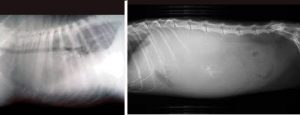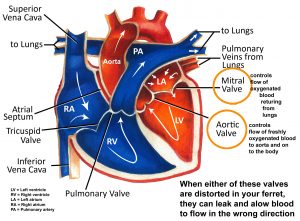Ron Hines DVM PhD
 Ferret Health Care Library Link
Ferret Health Care Library Link
As ferrets begin their senior years, their susceptibility to a number of diseases increases. One of them concerns issues relating to their heart. There are a number of them – but all can eventually result in heart failure (= CHD = congestive heart disease). Ferret owners rarely notice the beginning signs of heart disease in their ferrets. They usually pass them off as no more than the normal aging process – less activity, decreased exploratory interest, picky eating and more sleep time. Without an extensive battery of tests, your veterinarian might not detect those early heart problems either. (read here) So by the time heart problems are discovered, they tend to be quite advanced. A second problem is that these older ferrets quite often have multiple health issues. (read here)
What Are The Common Heart Issues That Ferrets Face?
Traditionally, veterinarians believed that an enlarging heart with thinned muscular walls, dilated/dilatative cardiomyopathy (DCM), was the leading cause of heart failure in ferrets. But as veterinary cardiologists became more sophisticated in their use of echocardiography, they found that heart valve problems are probably more common than DCM. (ref) It is likely that many cases of DCM begin with heart valve issues. Regardless of the underlying cause(s), almost all heart-related problems in ferrets eventually result in congestive heart failure (CHF).
Heart valve Problems:
What veterinarians know today about heart valve problems in ferrets rests primarily on some studies conducted by a group of veterinary specialists reviewing the ferret records accumulated at the Angell Animal Medical Center, in Boston. They found that distortions of valves (the mitral and aortic valves) that direct blood flow into and out of the left lower muscular chamber of the heart (the left ventricle) was the most common heart defect in ferrets. Whenever either of those valves do not close fully, blood flows in the wrong direction (regurgitates) whenever the chamber contracts (=a heart beat).
In humans and other animals, scaring and distortion of those valves due to the wear and tear of time is a common cause. In other cases, infectious bacteria lodged on the valves causing scaring and contraction of the individual valve leaves (leaflets). Veterinarians do not know the underlying causes of heart valve disease in ferrets.
With time, the ferret’s heart chambers enlarge due to abnormal pressures and increased work load, similar to congestive heart failure/CHF in people. These stretched, enlarged chambers can also damage the heart’s electrical system resulting in abnormal heart beats (arrhythmias) or a galloping (fast) pulse.
Cardiomyopathies:
Dilated/Dilatative Cardiomyopathy
MIT in Boston pioneered the use of ferrets in biomedical research. In 1987, they described an 8-year-old ferret from the Worcester Science Center brought to them near death due to heart failure. Its heart was very enlarged and flabby. Much of its heart muscle had been replaced by scar tissue interspersed with inflammatory cells (monocytes). The condition of its heart valves were not noted. They diagnosed the ferret’s problem as dilatative cardiomyopathy.
To this day, we do not know whether DCM is a primary disease in ferrets or just the result of heart valve failure. In cats, it is known to occur due to a taurine deficiency. It is rare in cat now because cat food manufacturers now add additional taurine. The prime source of taurine in your ferret’s diet is meat. So, a diet deficient in meat could conceivably be involved. In 2018, the FDA began investigating a potential link between canine diets and an increased occurrence of DCM in dogs. In 2019, they announced that there appeared to be a link between diets containing peas, lentils and potatoes and the increase in canine DCM cases. No one yet knows why and no one knows if this has any bearing on DCM in ferrets.
Hypertrophic Cardiomyopathy
A second and much rarer form of cardiomyopathy has been occasionally reported in ferrets. In that form (HCM or hypertrophic cardiomyopathy) the heart walls thicken and eventually fail. (ref) It is a more common problem in cats. (read here) An ultrasound examination by your veterinarian will tell the two apart. Current treatments are the same as for DCM.
Heartworms
Most ferrets with heart issues do not have heartworms. But if you live in a heartworm area, and you do not give your ferret a monthly heartworm preventative, and if your ferret is exposed to mosquitoes, it has the potential to become infected with canine heartworms. The signs of heartworms in ferrets are the same as the signs of heart failure due to the other causes I mention. A single adult heartworm is sufficient to cause severe heart and lung problems. However, the tests used to detect heartworms in dogs are not very sensitive in detecting heartworms in ferrets. Those tests rely on sufficient heartworm antigen (large molecules originating from the heartworm’s surface) being detected. Those antigens are rarely if ever in high enough concentration in small animals like ferrets whose heart and lung vessels are only large enough to harbor a heartworm or two. Tests that look for living heartworm larva in the blood stream also commonly fail because it is rare to find those microscopic larvae (microfilaria) in ferrets (they are said to be present in only 25-50% of cases and are easily missed). Occasionally, the adult heartworm can be visualized during an ultrasound exam. Suspicions increase when a ferret with heart and lung issues lives, without monthly heartworm preventatives, in a heartworm zone and is young (under 3-4 years of age). Treatment options are the same as they are for cats, but as with cats, successful treatment is a rarity.
If My Ferret has Heart Problems, What Signs Might I See?
Because weakened hearts have limited options to compensate for reduced abilities, the signs of all forms of heart failure are quite similar.
Blood is no longer flowing efficiently through the ferret’s body delivering necessary oxygen to cells. Early in a heart issue, that just leads to a loss of energy and vigor. These ferrets tend to tire easily. They lose a ferret’s normal inquisitiveness and playfulness.
In more advanced cases, if you check your ferret’s pulse, it might be abnormally fast and weak. A normal relaxed ferret’s pulse and heartbeat is about 140-210 beats per minute. In ferrets with advancing heart issues, their resting heartbeat is often more rapid than that. But when the heart enlarges and its internal electrical system is stretched and damaged, the pet’s pulse and heartbeat can actually be slower than normal. In those situations, the pulse and heartbeat are often irregular (arrhythmic) as well.
As time goes by, sluggish blood flow allows fluid to pool in their tummy and lungs. So, a potbelly (due to ascitic fluid) is common. Infrequently a soft cough is present as well. Some notice that their ferret’s gums are a bit bluish and/or pale. Respiration is usually fast and sometimes labored (dyspneic). The normal respiration rate of a ferret is about 30-36 breaths per minute.
With time, these ferrets also tend to lose muscle mass. Although their tummy’s often appear large due to liver congestion and pooled fluid, their backs are bony, and leg muscle mass is reduced. The normal weight of a healthy adult male ferrets is about 1.9-2.6 lbs (0.9-1.2 kg). Adult females should weigh about 1.4-2.2 lbs (0.6–1.0 kg). Many ferret’s weights also vary according to the season of the year – particularly in those exposed to natural sunlight. Body weight can be deceptive because any abnormal chest or abdominal fluid adds weight as well.
Rear Leg Weakness & Lameness
There are a lot of non-cardiac reasons why a ferret might be limping or weak in its hind legs. It may have gotten stepped on or injured a joint. It might have a back injury. A toenail might be broken or infected, or it might just be weak – ferrets with generalized weakness often show it most in their rear legs.
But when blood flow through the heart is abnormally slow (as it is in CHF), blood clots sometimes form in the left atrium and pass on into the ferret’s general arterial blood circulation. A common place for those blood clots (embolisms) to finally lodge is where the major arteries divide to supply blood to each rear leg. This problem is more common in cats with heart disease. (read here) It also occurs in ferrets. It can affect blood supply to both rear legs or just one rear leg. Common signs are leg weakness or paralysis, a weak femoral pulse and lower than normal leg temperature. It might be mistaken for a spinal cord injury. These blood clots also have the potential to lodge in the kidneys.
In dogs cats and humans, the proBNP test and tests similar to it can identify heart problems that might result in this problem. However, there is little veterinary experience or confirmation that these tests are helpful in ferrets – although theoretically, they should be.
What Diagnosis Test Will My Veterinarian Use To Confirm My Ferret’s Heart Problem?
As I mentioned, the very early stages of heart disease in ferrets are likely to be overlooked. Outwardly, these animals appear perfectly normal. Only a doppler echocardiologic ultrasound examination is likely to detect the early-stage heart disease in ferrets. Because of the time and expense involved in having an imaging specialist run this test, it is rarely performed without hard evidence that there is a need for it.
As heart disease progresses, your veterinarian will look for the same telltale signs that I mentioned that you should look for.
Your vet will likely press down on a portion of your ferret’s gums to note how long it takes for the pink color to return (the CRT test). An increased CRT time indicates poor blood circulation. Normal capillary refill time (=CRT) in ferrets is less than three seconds.
A stethoscope will tell your veterinarian a lot. The device is a good way to measure your pet’s heart rate, detect heart beat abnormalities (arrhythmias), detect fluid-filled lungs (moist rales/ pulmonary edema) or free edema fluid present in the chest. Heart murmurs due to heart valve issues or anemia might also be identified. (read here & here)
Some ferrets with heart disease also run fevers. I do not know if these fevers are due to the increased muscle exertions required to breathing in enough oxygen or due to secondary lung infections – perhaps on occasion both. Breathing issues also make many ferrets with heart disease resent being restrained for their veterinary examination (oxygen masks or chambers need to be held at the ready).
The possibility of other common health issues with similar signs will probably cross your veterinarian’s mind and need to be ruled out – things like heatstroke, anemia, dehydration, insulinoma, lymphoma other cancers, intestinal obstruction, etc. Perhaps even influenza.
It might already be apparent to your veterinarian at this stage that your ferret has free fluid in its chest that is obstructing its breathing. If so – and if the ferret can withstand the procedure – a sample of that fluid will likely be collected (=thoracentesis) and analyzed. Based on the physical characteristics of the fluid and the cells it contains, this procedure can differentiate problems like lymphoma and pneumonia from heart failure.
X-rays:
In advanced heart disease, radiographs will tell your veterinarian a lot. In those cases, the heart will have lost some or most of its normal shape – becoming larger and more rounded (globoid). Free fluid (effusions) may be visible in the chest or suspected in the abdomen.  (read here)
(read here)
When blood circulation is abnormally slow due to heart failure, blood also tends to pool in the liver and spleen increasing their size. When present, that is also apparent on x-rays (=hepatomegaly, =splenomegaly).
Electrocardiograms = ECG = EKG
If your veterinarian elects to place leads on your pet and examine its heart’s electrical system in moderate or advanced heart failure, abnormalities will most likely be discovered. There are international services that will assist your veterinarian in interpreting the results. (ref)
Echocardiography
Echocardiography is a sophisticated type of ultrasound examination that allows your veterinarian to visualize your ferret’s heart, the heart’s valves and blood flow patterns within the heart on a screen or monitor. It combines standard ultrasound with the doppler effect. This technique even allows your veterinarian to gauge pressures within the heart itself. Doppler ultrasound exams are the most effective way to discover early heart problems in ferrets and to gauge their severity independent of the symptoms seen.
Ultrasound, both doppler and non-doppler, is also the best way to differentiate the two forms of cardiomyopathy (DCM & HCM) from each other. It can also help rule out or rule in the presence of thoracic (chest) lymphoma which can produce symptoms similar to degenerative heart disease. These procedures are also quite important in gauging the success of your veterinarians treatment plan as time goes by.
Blood Sample Analysis:
Blood analysis in the early stage of ferret heart disease is usually normal. When specific blood constituents are elevated, they are usually ALT, Alk Phos and BUN along with electrolyte imbalances. I have no explanation as to why BUN is often high in ferrets with heart disease. Elevated BUN It is associated with kidney damage (and occasionally dehydration). As I mentioned, older ferrets often have multiple health problems. Kidney health also depends on proper blood flow, so the two problems could also be related.
Treatment In Emergency Situations
As I also mentioned earlier, many ferrets only reach their veterinarian when they are in a heart-related crisis. By then, considerable irreparable damage to their hearts has already occurred.
In respiratory-distressed (dyspnea) ferrets, supplemental oxygen is often the most important element during a heart crisis. More time-consuming tests are often best delayed. Those requiring firm restraint are best put off as well.
These ferrets often benefit from intravenous injections of a diuretic like furosemide (Lasix®). But even then, it can take up to a half hour for the drug to give respiratory relief. (read here)
A quick set of x-rays or an ultrasound exam without major restrain might not provide the clearest images, but they will be good enough to confirm an enlarged heart and fluid-congested lungs.
In some emergency situations, withdrawal of chest fluids through a needle is the only fast enough solution. (read here)
Subnormal body temperature is a grave sign (a ferret’s normal body temperature is 100 – 103F (37.8 – 39.4C). Your vet will likely add a supplemental heat source if it is below 100F (=hypothermia).
Many of these critically ill ferrets receive antibiotic injections (such as ampicillin/amoxicillin/cefazolin) as well. That is because the diagnosis at that point is not firm and secondary bacterial pneumonia could be present.
Dehydrated ferrets require intravenous or subcutaneous rehydration fluids such as Ringer’s solution – or better yet, custom electrolyte solutions which have been formulated based on the current chemical analysis of the pet’s blood (electrolyte balance).
What Long-Term Treatments And Management Techniques Are Available For My Ferret?
Veterinarians rely on the same medications and treatment plans for heart disease in your ferret as they do for heart disease in dogs and cats. Just about all the medications veterinarians use in cardiology are the same ones physicians use to treat CHD in humans. The drug doses are adjusted to fit the ferret’s lower body weight and higher metabolic rate. (read here) However, medication effectiveness in ferrets is just assumed, based on their effectiveness in heart disease in other species.
Medications To Increase The Force Of Your Ferret’s Heart Contractions
Traditionally, veterinarians placed these ferrets on oral digoxin, a drug that improves the strength and efficiency with which the heart beats. In many cases, digoxin also helps slow abnormally fast heartbeats. But digoxin can produce a number of serious and sometimes life-threatening side effects. Ferrets are quite small, so the window between a therapeutic dose and a toxic dose is very narrow. I personally avoid dispensing digoxin to any of my client’s pets. The side effects for me have always been too great. As an alternative, some veterinarians including myself prescribe an alternative medication, pimobendan (Vetmedin®). It also increases the heart’s pumping strength (a positive inotrope).
Drugs That Allow Blood To Flow More Readily Throughout The Body
These medications do so by relaxing the walls of blood vessels. Your veterinarian would probably place a dog or a cat with similar heart issues on an ACE inhibitor such as enalapril (Enacard®) or benazepril (Fortekor®, Lotensin®). However, this group of medications commonly cause a ferret’s blood pressure to drop too low. Perhaps that is due to some idiosyncrasy of ferret metabolism. Perhaps it is due to the difficulty in calibrating just the right dose for a creature with such a low body weight.
As an alternative, your veterinarian might decide on a calcium channel blocker like diltiazem (Cardizem®), particularly when heart beat irregularities/arrhythmias are present. Another group of alternative medications are beta-blockers such as atenolol (Tenormin®). As with all these cardiac drugs, finding the small window between a helpful dose and a detrimental dose is critical. So close monitoring and frequent dose adjustments are always required.
Diuretics
If you have read this far, you know that defective hearts often allow fluids to pool in the ferret’s chest and abdomen. Preventing fluid pooling around and in the lungs is critical to a ferret’s comfort and survival. The drugs that are helpful in reducing pooled fluids are called diuretics. The most common one given to ferrets with heart problems is furosemide (Lasix®). I mentioned it earlier. It comes in both oral and injectable forms.
Like all medications, the dose size and dose frequency must be individualized for each ferret. A few ferrets can get by with the drug given only once a day. More frequently, it requires a morning and evening dose. All diuretics promote dehydration and thirst. So fresh water must be easily available to your ferret at all times.
When a twice-daily dose of furosemide is no longer effective, some veterinarians add as a second diuretic, spironolactone (Aldactone®). I have no experience giving this drug to ferrets.
The only alternative in cases no longer responding to diuretics is to have the excess fluids periodically drained from your ferrets chest and abdomen (thoracentesis).
Blood Thinners
In cases where blood clots are suspected or feared, such as when rear leg weakness or secondary kidney damage occurred, one might consider several of the medications currently used to treat atrial fibrillation in humans (A-fib). I have no experience giving these medications to ferrets. In cats, Plavix® has been used. (read here)
Dietary Changes?
Whether a salt-restricted diet is helpful for ferrets with heart issues remains unknown. The effects of taurine-suplemented diets is also unknown. Therapeutic diets for cats and dogs with heart issues are moderated in their sodium content; but there are dangers in feeding truly low sodium diets. (read here)
I would personally feed heart-issue ferrets commercial high-protein moist or home-prepared moist diets that contain 70-80% water. That sounds like a lot of water, but it is the percentage water in many canned cat foods and about the amount of water present in whole rodents. On occasion, furosemide also causes blood potassium levels to drop below normal. That also needs to be monitored and supplemented when required.
Consider cooking for your ferret. There are plenty of trusted recipes from seasoned ferret owner on the internet (nothing bizarre please); or you can have an online veterinary nutritionist experienced with zoo carnivore nutrition prepare a custom recipe and a balanced supplement for you. I am not saying that doing so will necessarily make your ferret live longer. But it will certainly make its remaining time on this earth more enjoyable.
Lower Life’s Stresses
Weakened (debilitated) ferrets do best when they are housed separately. If you are keeping several ferrets, prepare a special handicapped cage for this one. Keep the temperature in its living space below 80F. Do not allow children to play with the pet and keep play times to a minimum.
How Much Longer Might My Symptomatic Ferret Survive?
I consider myself blessed when a client’s ferret showing many of the symptoms I mentioned earlier survives an additional 8 months. Longer survival times are quite rare.
You are on the Vetspace animal health website
Visiting the products that you see displayed on this website help pay the cost of keeping these articles on the Internet.


